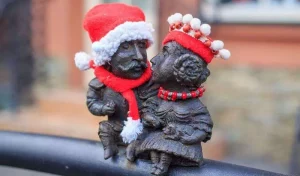🕒 Date of last update of the article: 16.02.2024 at 9:11 p.m | 🖋 Author: Viktor Shatrov
Надсилайте актуальну інформацію та отримуйте більше цільових клієнтів. Ми розмістимо ваш об’єкт у нашому каталозі та покажемо поруч із локаціями, а також у загальному каталозі, це безкоштовно!
🕒 Date of last update of the article: 16.02.2024 at 9:11 p.m | 🖋 Author: Viktor Shatrov
This small attraction was opened with the help of the NGO Pannonia and the Consulate General of Hungary in Uzhhorod. The grand opening of this romantic monument took place on 14 December 2015. This mini-sculpture became the 26th masterpiece by sculptor Mikhail Kolodka in the regional centre Transcarpathia.
The sculpture depicts lovers frozen a moment before a kiss. This romantic sculpture is located in the very centre of Uzhhorod on Pravoslavna embankment near the Hungarian Consulate (GPS: 48.620900, 22.298636).

Content
| 🗺 Location | N48°37′15.46″ E22°17′54.78″ |
| 🗽 Opening date | 14.12.2015 |
| 🧑 Sculptor | Mykhailo Kolodko |
| 🧭 Distance from the center of Uzhhorod | Near |
| 🚙 Road for | Car, on foot |
| 🏕 Stop with a tent | No |
| 🏡 Housing nearby | Uzhhorod |
| ☕ Cafes and shops | Uzhhorod |
Miklos Bercheni and Kristina Chaki are a symbol of the Hungarian people’s struggle for independence. At a young age, Miklos Bercheni became the owner of Uzhhorod Castle, which he inherited after the death of the last male representative of the Druget family. His first wife came from this noble family. At the age of 22, young Miklos became a widower. His three children were left as half-orphans. A few years later, fate brought Miklos Bercheni together with Kristina Chaki, also a widow. Before meeting Miklos, Kristina Chaki had been married twice, but she was widowed both times. Miklos Bercheni was half her age. Despite this age difference, love reigned in their family. Kristina was the daughter of state judge Istvan Bercheni and came from a wealthy family. In addition, despite her age, she was a real beauty.
After the suppression of the uprising led by Ferenc II Rákóczi, Miklos Bercheni, who was an active participant in the Hungarian struggle for independence, was declared a traitor, so he and his wife were forced to leave their residence in Uzhhorod in 1710 and flee abroad. Miklos and Kristina never returned home and died in modern-day Turkey.
An interesting legend about this mini-sculpture is told by Nadiya Popadiuk in her book Uzhhorod – the World Capital of Mini-Sculptures. According to the legend, in 1695, a delegation from Japan visited Uzhhorod Castle, which was owned by the couple Christina Chaki and Miklos Bercheni at the time. In addition to addressing political issues related to the development of trade relations with the Netherlands (at that time, Japan had severed all ties with the Western world and was pursuing a policy of sakoku, or isolation from Europe, with Holland being an exception), Japanese diplomats presented the hospitable family with Japanese cherry saplings. They also spoke about the ancient Japanese tradition of hanami, or admiring the cherry blossom, which, according to the Japanese, prolongs life for up to a hundred years.
The owners of the Uzhhorod Castle liked this custom very much and later began to spend time admiring the sakura (they rested under the blossoming trees, enjoying light drinks, music and games). After the defeat of the War of Independence in 1711, Miklos Bercheni chose the fate of an exile and together with Kristina he settled in distant Turkey, leaving mini-sculptures in memory of themselves on the Uzhhorod embankment opposite his favourite Flower Park (modern Botanical Garden).
| 🔰 Start | From the mini-sculpture “Tyvadar Chontvari” |
| 🚶 Walking distance (along the Orthodox Embankment) | 55 m |
| 🕒 Approximate time | 1 minute |
| ⬆ Rise | Mostly without ups and downs |
Author of the article: Viktor Shatrov
Number of articles: 1100+
Knowledge of languages:: Ukrainian, English
Favourite quote: “Travelling – the only thing that makes you richer“
He was born and lived all his life in Uzhhorod. He graduated with a gold medal from Uzhhorod School No. 1 named after Taras Shevchenko (now Uzhhorod Lyceum named after Taras Shevchenko). He studied at the History Department of UzhNU, graduating with honours in 2009. He worked as a senior researcher at the Transcarpathian Museum of Folk Architecture and Life, a lecturer at the East European Slavic University.